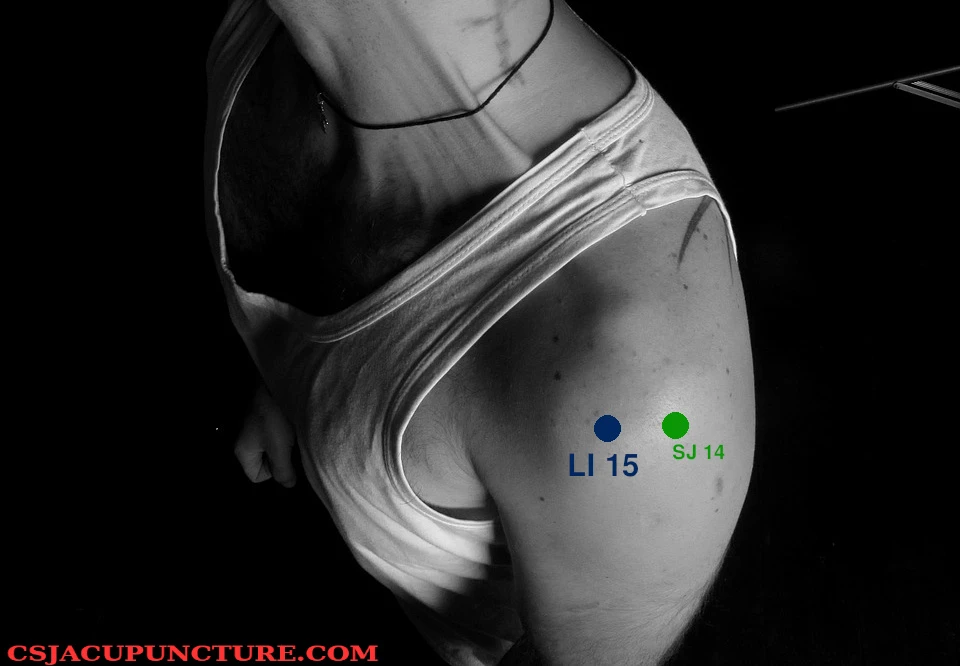This post may contain affiliate links and ads in which we may earn a small percentage of purchases.
The next acupuncture point we’re going to cover is Large Intestine 15 (Li 15).

If you’ve ever quit because meal plans felt overwhelming, this approach keeps it simple. The 21-Day Smoothie Diet gives you daily guidance, a detox reset, and easy recipes—so you can focus on consistency instead of planning. Instant digital access. Start today.
Professional-grade Korean cupping set with 17 durable cups and extension tube for muscle therapy.
 View Cupping Set
View Cupping Set
LI 15, also known as “Jianyu or shoulder bone (TCM) “Gyeonu” (Korean Acupuncture), is a significant acupuncture point on the Large Intestine Meridian often used for treating shoulder issues, including frozen shoulder (adhesive capsulitis).
Quick Links
LI 15 Acupuncture Point Location
LI 15 is located at the anterior and lateral aspect of the shoulder, in the depression that appears when the arm is abducted (moved away from the body). It’s found at the junction between the deltoid muscle and the acromion process.
Needle Depth
This point is needled perpendicularly, allowing for a slightly deeper insertion. A 1.5 cun needle can be used as long as the point is located properly. Research has suggested that a 30–40 mm acupuncture needle “should be suitable for the stimulation of the subacromial space”, which includes the supraspinatus tendon and the subacromial bursa in regards to inflammation.1
Portable dual-channel TENS/EMS device with 24 therapy modes for targeted muscle and pain relief.
 View Device
View Device
A clear and beginner-friendly guide covering over 400 acupuncture points, ideal for students and learners.
 View Book
View Book
A stainless-steel acupuncture pen and gua sha set for massage, reflexology, and tension relief.
 View Product
View Product
What Are The Functions Of Acupuncture Point LI 15?
Acupuncture Theory:
- Removes obstructions from the channel(Bi syndrome)2
- Expels wind, and resolves phlegm
- Accumulation of phlegm and blockage of blood and qi flow3
Biomed functions:
- Shoulder Pain
- Weakness of the Shoulder
- Weakness and tingling along the arm
- Periarthritis4
- Frozen Shoulder5
- Shoulder Impingement Syndrome6
- Hemiplegia due to stroke7
Combining LI 15 With Other Points
LI 15 is often combined with other shoulder-related points to enhance its therapeutic effect, particularly in addressing pain and improving range of motion. A common combination is with San Jiao 14 (Jianliao), located on the posterior aspect of the shoulder at the posterior border of the acromion. Together, these points work synergistically to treat shoulder joint pain and stiffness from different angles. Additionally, LI 14 (Binao), located at the base of the deltoid muscle, is frequently paired with LI 15. This combination is especially useful for treating pain and tension in the deltoid and upper arm. Using these points together provides a more comprehensive approach to managing shoulder-related issues.
Research on LI 15
A 2005 study in the Journal of Acupuncture and Tuina Science Electroacupuncture on LI 15 was shown to be an effective treatment for shoulder periarthritis. and had more significant effect than oral Diclofenac Sodium Sustained-release Capsules.8
A 2017 study published in the BMJ Open examined the Pressure Pain Thresholds (PPTs) and three acupuncture points SJ 14, LI 15, and SI 9 Showing a relationship amongst the points and pain.9
A 2020 systematic review and meta analysis of acupuncture for frozen shoulder revealed again the most common acupuncture points used were Large Intestines 15 and San Jiao 14.10
A 2021 review of six randomized controlled studies in the Journal of Acupuncture Research examined the use of acupuncture in Shoulder Impingement Syndrome (SIS). In all six(6) the acupuncture treatment group showed significant positive changes in “pain, disability, and quality of life”.11 The worldwide study also found that LI 14, LI 15, and San Jiao 14 were the most frequently used point. No major adverse effects were reported.
Contraindications and Precautions:
- Fractures
- Infections
Versatility of LI 15
LI 15 is a versatile point that can be effectively used in clinical practice, especially for treating shoulder-related conditions. Based on my experience, some acupuncture points can be directly needled serving as localized points to address specific or radiating areas of discomfort or dysfunction. LI 15 is one such point, offering reliable therapeutic benefits when applied properly, making it a valuable tool in acupuncture treatment for shoulder pain and mobility issues.
This information is for educational purposes only. Please consult with a healthcare provider for any diagnosis or treatment.
References
- Lee* KH. How to Insert Acupuncture Needles into the Subacromial Space through LI15. J Acupunct Res 2021;38:242-244. https://doi.org/10.13045/jar.2021.00129 ↩︎
- Maciocia, G. (2011). The Foundations of Chinese Medicine: A Comprehensive Text For Acupuncturists and Herbalists. Elsevier 2nd Ed. Pg 914 ↩︎
- Park JE, Kim WY, Lee SJ, et al. Acupuncture treatment for shoulder impingement syndrome: A review of randomized controlled trials. J Acupunct Res. 2021;38(3):175-182. doi:10.13045/jar.2021.00073. ↩︎
- https://link.springer.com/article/10.1007/BF02845491 ↩︎
- Ben-Arie, Eyal, Kao, Pei-Yu, Lee, Yu-Chen, Ho, Wen-Chao, Chou, Li-Wei, Liu, Hsin-Ping, The Effectiveness of Acupuncture in the Treatment of Frozen Shoulder: A Systematic Review and Meta-Analysis, Evidence-Based Complementary and Alternative Medicine, 2020, 9790470, 14 pages, 2020. https://doi.org/10.1155/2020/9790470 ↩︎
- Park JE, Kim WY, Lee SJ, et al. Acupuncture treatment for shoulder impingement syndrome: A review of randomized controlled trials. J Acupunct Res. 2021;38(3):175-182. doi:10.13045/jar.2021.00073. ↩︎
- Lee* KH. How to Insert Acupuncture Needles into the Subacromial Space through LI15. J Acupunct Res 2021;38:242-244. https://doi.org/10.13045/jar.2021.00129 ↩︎
- Tao, C., Min-lei, Q., Zhi-ping, X. et al. Clinical study on treatment of shoulder periarthritis with electro-acupuncture on point Jianyu (LI 15). J. Acupunct. Tuina. Sci. 3, 25–27 (2005). https://doi.org/10.1007/BF02845491 ↩︎
- Yan C, Zhang S, Li Q, et al. Detection of peripheral and central sensitisation at acupoints in patients with unilateral shoulder pain in Beijing: a cross-sectional matched case–control study.BMJ Open 2017;7:e014438. doi: 10.1136/bmjopen-2016-014438 ↩︎
- Ben-Arie, Eyal, Kao, Pei-Yu, Lee, Yu-Chen, Ho, Wen-Chao, Chou, Li-Wei, Liu, Hsin-Ping, The Effectiveness of Acupuncture in the Treatment of Frozen Shoulder: A Systematic Review and Meta-Analysis, Evidence-Based Complementary and Alternative Medicine, 2020, 9790470, 14 pages, 2020. https://doi.org/10.1155/2020/9790470 ↩︎
- Park JE, Kim WY, Lee SJ, et al. Acupuncture treatment for shoulder impingement syndrome: A review of randomized controlled trials. J Acupunct Res. 2021;38(3):175-182. doi:10.13045/jar.2021.00073. ↩︎
Medical Disclaimer: This article is for informational and educational purposes only and is not a substitute for professional medical advice, diagnosis, or treatment. Always consult a qualified healthcare provider with any questions about a medical condition or treatment.







